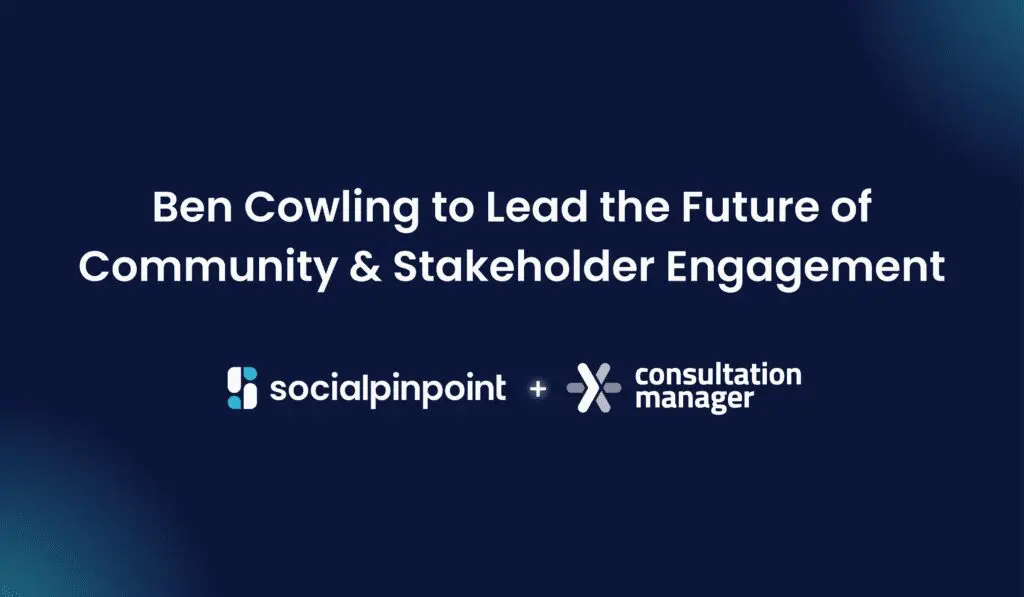Hybrid community engagement strategies combine face-to-face and online tactics to reach a broader cross-section of the community. After gaining momentum during the pandemic, this blended approach is becoming an industry standard because it gives people more choice over how they participate.
In community and stakeholder engagement, we are constantly asking people to tell us about their hopes and aspirations for the future. Then we take away those insights to make better decisions throughout a project and hopefully, deliver that future in a meaningful and tangible way.
Our goal is to create real and lasting value for the communities that we serve. However, we’re starting to come across a variety of new challenges, that are changing how we have traditionally engaged with our communities.
The accelerated uptake of digital technology has given the public more access to information (and misinformation alike), coinciding with the rapid emergence of polarized public sentiment. This is translating to a continued lack of trust and uncertainty in decision-making.
However, a new opportunity is emerging within these challenges.
Improving trust is critical to building the public and political support required to create meaningful change and it can be built with effective community engagement strategies that enable more people to participate in key phases of decision-making.

Community and stakeholder engagement professionals who can accelerate their organization’s learning will also excel in this uncertain environment, because we can’t use the same old thinking to create novel ideas that benefit the planet as a whole.
As a result, community engagement experts are inviting new voices into the conversation by layering online tools with traditional offline engagement techniques.
What is a hybrid community engagement strategy?
Hybrid community engagement is an effective strategy that you can use to connect with more people and gather representative input.
Combining offline and online engagement techniques, the approach gives people as many avenues as possible to have a say in the decisions that impact their lives.
Face-to-face methods are personal and in-depth. However, you can reach more diverse members of your community and gain broader insights by combining them with cost-effective online experiences.
What are some examples of hybrid community engagement strategies?
A hybrid community engagement strategy combines complementary face-to-face and online engagement techniques.
Here are a few easy examples to begin with:
- Conduct face-to-face meetings or pop-up events with the aid of iPads
- Utilize QR codes on physical posters and mail-outs to drive traffic online
- Have an identical survey available for people to fill out offline or via an online tool
- Provide access to online information at libraries, recreation centers, or similar community spaces

A hybrid community engagement strategy in action:
Here’s how you might put all of these examples of a hybrid community engagement into a multi-step plan.
- Your team could host outreach events in community and neighborhood places to raise awareness of your project and let people have face-to-face conversations.
- You then might leverage an online component to capture the community’s sentiment and ideas in real-time.
- You could provide iPads and place QR codes on printed materials so that community members can easily share their thoughts online. This online community engagement page could be open throughout your project and accessible to anyone with an internet-connected device.
- You could also use signage with a QR code in the local community and direct people who live, work, and travel there to the online engagement space.
These approaches work well when you’re trying to reach a diverse cross-section of people and build a community of participants with a limited budget. They give the community multiple ways to participate, depending on their capabilities, time availability, resources, and preferences. As a result, they reduce the barriers to participation and allow you to gather more feedback efficiently.
Face-to-face engagements with specific community groups will always be essential. But, if you’re eager to give your community more ways to participate, then you can layer digital techniques with traditional approaches.
Consistently pointing stakeholders towards an online community space keeps them informed and lets them influence projects and plans with a variety of online participatory tools. Plus, if you use an integrated and multichannel promotion plan, then you can also drive even more people to your online engagement page.
What are the benefits of a hybrid community engagement strategy?
The community engagement experts who have started layering offline and online techniques have become more inclusive and increased their community member engagement rates. This all equates to higher quality data, better decisions, increased public trust, more collaboration, and big, bold, new ideas.
Inclusivity
Combining face-to-face and digital engagement methods means that different community groups can provide feedback via their preferred method. As a result, more people can weigh in and better decisions can be made with representative data.
Efficiency
You can also reach far more people by adding online tools into the mix, without dramatically increasing the costs and carbon footprint of bringing people together. Your team will have more data, become more agile, and come up with informed solutions that the community will buy into.
Trust
Presenting information transparently in a widely accessible online format also helps to build trust with communities and involves them in the planning process. It gives them the opportunity to learn about the project in key stages, while broadening their perspective on its benefits and impacts.
It’s also easier to keep stakeholders in the loop. Someone might have engaged with you face-to-face and you can keep them posted on how their input has been used online.
Diversity
Hybrid community engagement doesn’t just boost the number of participants. It also improves the quality of interactions.
Using a variety of offline and online engagement techniques improves accessibility and invites new groups of people with certain interests into the conversation. As a result, every group is exposed to “other” people with different interests.
Innovation
Different views and priorities can collide giving everybody a far better perspective on the future direction of a place. Connecting polar perspectives also ignites new ways of thinking, drives productivity, and improves innovation.
Insights
You can also tap into historical project data more easily and leverage past insights about how community members feel. When you have an online space to store community interactions, you can build up a long-term knowledge base about what your community and stakeholders care about.

Is face-to-face or online community engagement better?
The debate about whether offline or online techniques are better is over. The focus is now on using the right tool for the use case and getting the balance right in your engagement plan.
The applications of hybrid community engagement will continue to grow and community engagement professionals can use these strategies to accelerate their organization’s learning. Engaging diverse people in conversations about the future can expose us to new ideas and make us ask questions that we haven’t thought of yet.
Technology can also enable us to analyze wider data sets and connect past learnings with new ideas to inform better decisions for the future.
The result? We can listen and learn to build a future that we all want to live in.
Effective community engagement strategies don’t just enable us to do what we’ve always done cheaper and faster. They also help us to scale up our learning capability and constantly rethink how we bring people together to live.












